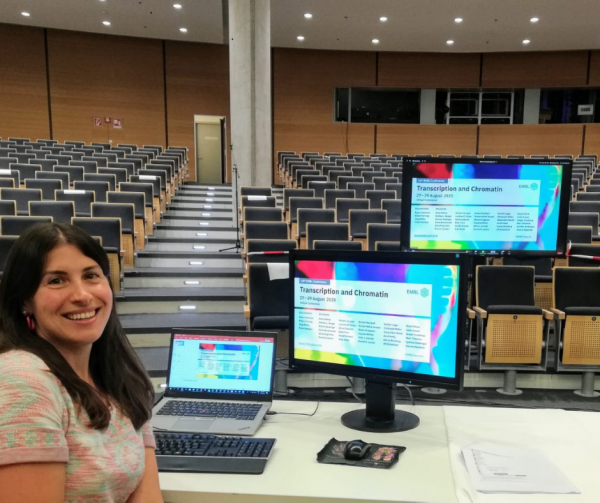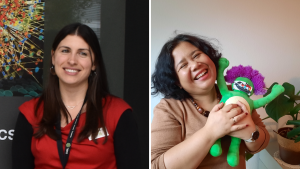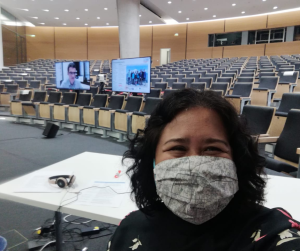Looking back on a year of organising virtual events

Exactly one year ago, the Covid-19 pandemic hit Europe. All on-site events had to be cancelled and we had to rethink our entire program. Our Course and Conference Officers worked really hard to create a virtual equivalent of EMBL’s on-site training offering. We successfully launched our first virtual conference and many more followed.
The learning curve was steep and so was the stress level. But when the going gets tough, the tough get going. Two of our Conference Officers, Nathalie and Diah, share with us their experience from being in the eye of the storm, the lessons they have learned and some tips for organising a virtual meeting.

How does organising a virtual event compare to organising an on-site event?
Diah: “It is a different world, but equally fun! Organising a virtual event is harder than people think and often more challenging. Not getting to see anyone in person and mastering all sorts of virtual platforms can be quite tough.”
Nathalie: “Some of the milestones we have are the same, for example: preparing the website, programme, opening registration, emails with participants and invited speakers, abstract review and selection… But a huge bulk of the work is totally different: instead of booking buses and ordering catering, we are setting up Zoom webinars and populating the virtual platform.
The massive change has been adapting to the new tasks we have to do and how we should do them consistently for all our events. In our team we have numerous working groups looking at areas of event organisation and creating guidelines, procedures and templates that will help us all. It really is a whole team effort!”
Read: Why do we charge fees for virtual events?
What kind of feedback do you get from participants, speakers and organisers?
Nathalie: “The feedback I have received from speakers and participants has been great: they are so happy we converted our event to virtual instead of cancelling/postponing it. Initially a few speakers were disappointed for the event to turn virtual but the same people commented afterwards that they were impressed with how well it went. What is wonderful is that it is still so beneficial for them in their continued research.”
Diah: “Very humbling! Many agree that onsite face-to-face events are somehow irreplaceable but at the same time they are amazed at the number of benefits virtual events offer too! They give you more flexibility: you don’t have to travel across the world. Also, some people feel more comfortable asking questions in the virtual format. “
What is the most important lesson you have learned about organising virtual events?
Nathalie: “It’s been necessary for us to turn to virtual events but the lessons we have learned are that virtual events are effective, valuable and have many advantages! We’ve noticed that participants feel more comfortable asking questions during Q&A, that virtual talks have had a wonderful response, that virtual networking works well and you can meet different people from all over the world just at your desk!
On a bigger scale, virtual events mean less travel and a lower carbon footprint and they are more inclusive as they allow some people to participate who couldn’t have done so before. This is hugely important and is a very positive outcome of this difficult situation and it will have an impact on how events are organised in the future.”
What do you miss most about on-site events?
Diah: “The buzz when everyone arrives and the ATC is full of people is very exciting – after all the planning, everyone is there! And my favourite moment is the end of the conference: everyone is smiling and happy and you wave goodbye to the buses that leave EMBL. That sense of relief and accomplishment at the same time. I miss that!”
Nathalie: “Parties! One of the best things about the onsite events is meeting the speakers and participants you’ve been in touch with for months and when it comes to the conference party, it is really fun to see everyone let their hair down and enjoy themselves! And taking silly pictures at the Photobooth with people is something I loved and a really cute memento of the conference. That is a small thing I miss too!”
What in your opinion makes virtual events better than on-site events?
Nathalie: “The inclusiveness: more participants can take part as there is not the same financial barrier (travel, accommodation) and people can join from anywhere in the world.”
Diah: “Virtual events are resilient. There is no need to cancel an event because of the weather or a disaster. Participants can attend the event from anywhere!”

A common criticism is that networking doesn’t work well in the virtual world. What is your experience with virtual social events?
Nathalie: “I think it is great to see how Zoom breakout rooms allow people to mix in small groups or 1-to-1. Particularly the speed networking translates very well.”
Diah: “It’s my favorite part of the programme and I am amazed at how well it has been accepted and running so far. We have had live-streamed concerts and participants love it. At one conference some of the scientific organisers even stayed for the whole duration of the social session and wanted to continue mingling even after it had finished.”
Read our blog on virtual speednetworking.
Top tips to keep in mind while organising a virtual event?
Nathalie: “First of all – be open-minded. There are so many new technologies out there and different things you can try!
Have clear guidelines and templates: you use so many different apps and systems that saving time when setting things up can be a lifesaver!”
Diah: “I would also say: Test, test and test. Glitches are always likely to happen, so be prepared and stay calm.”
Read our blog for more tips on how to organise a virtual event
How do you see the future of EMBL Events?
Nathalie: “I hope we will embrace this new world of virtual events and have effective hybrid events in the future: allowing for face-to-face interaction for those who want to come on-site, but also giving the opportunity for those who prefer to join virtually and get the benefit of being part of the event without having to leave their home!”
Diah: “I think hybrid events will take a central place in the format of EMBL Events in the future. But whatever the format will be, we will keep improving and finding the best way to support the scientific community.”
Looking back in general, what are your thoughts?
Diah and Nathalie: “It has been very rewarding during the last year to see how we at EMBL have been able to adapt to the situation we have found ourselves in and been able to ensure that we can still provide a platform for scientific exchange. The aim of EICAT is to provide excellent training to scientists, and, despite the challenges, this is being achieved virtually for the first time! We are really proud of being able to provide opportunities for this exchange of knowledge and research.
Personally, this time has also been one of continuous learning for all of us on the team. We have developed our skills and experience in a number of ways and massively increased our knowledge of online platforms and tools! It has truly been a time of teamwork as we have adapted into the virtual event world and we are grateful to everyone involved: our marketing team, our Photolab technicians, designers and scientific organisers. It has been a challenging but very valuable learning experience!”